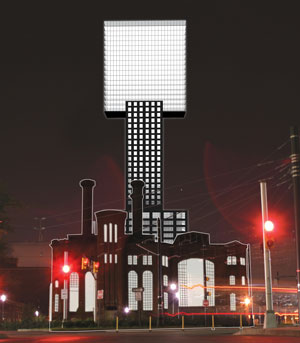The skyline of Jersey City, New Jersey, which faces lower Manhattan from across the Hudson River, increasingly seems like a mirror image of its neighbor: a parade of gleaming high-rise buildings line its waterfront. For developers and city officials, that’s exactly the point. They hope to lure businesses by creating something that looks and feels like Manhattan, but with lower tax bills and cleaner streets.


Images courtesy OMA
Jersey City may have tipped the scales more in its favor with 111 First Street, a proposed 1.2-million-square-foot, 52-story tower designed by Rem Koolhaas—the first major residential project in the U.S. for the Dutch architect’s Office for Metropolitan Architecture (OMA). The building resembles a stack of four giant Lego blocks, turned at alternating right angles. Its top block will feature 150 condominium units, with 180 more units and 252 hotel rooms in the shaft below it, and retail stores occupying 87,000 square feet in the pediment. To compensate for the demolition of artists’ lofts that had occupied the site, plans also call for 120 lofts priced at below-market rental rates for artists, plus 19,000 square feet of galleries where these residents can show their work.
In choosing Jersey City for its debut, OMA joins Cesar Pelli’s firm and Kohn Pedersen Fox, which have also recently designed buildings there. But Shohei Shigematsu, director of OMA’s New York office, says that proximity to big-name architects did not affect the firm’s decision—quite the opposite. The surrounding area’s low density allows for a clear view of OMA’s building from multiple vantage points. “In New York, this would be just another facade,” Shigematsu says.
But there are some people who may not look upon the building admiringly—especially those who were locked in four years of court battles to prevent the developer, a partnership between the Athena Group and BLDG Management, from destroying a tobacco warehouse on the site that had been converted into residences.
“They’re trying to cram in large buildings without regard to aesthetics, open space, historic resources, and community planning,” says Joshua Parkhurst, president of the Jersey City Landmarks Conservancy, a group that formed to slow the development boom. He would rather see Koolhaas’s tower built elsewhere, or its scale reduced. The building severs the waterfront from historic warehouses behind it, Parkhurst says, and people might never venture beyond it. “There’s no transitional zone here, and this could be the gateway to the industrial past of the city.”
